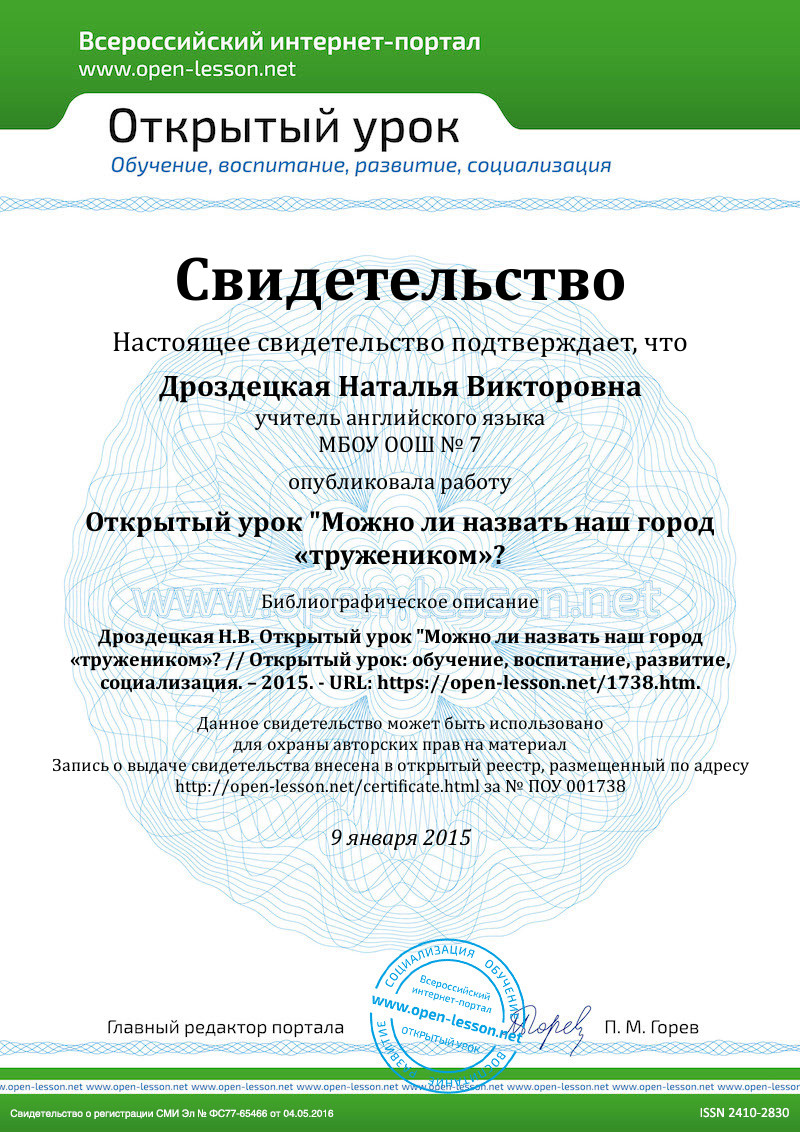for the labour are cast
(A.Tvardovsky)
- групповая;
- индивидуальная.
- Раздаточный материал – карточки-задания по теме «Школа».
- Презентация «Улицы родного города».
- Записи на интерактивной доске.
- Рабочие тетради учеников.
|
Этапы |
Деятельность учителя |
Деятельность учащихся |
|
1.Оргмомент |
Приветствует учащихся, проверяет готовность к уроку и создает благоприятный психологический настрой. |
Готовят рабочие места, проверяют наличие учебников и тетрадей. |
|
2.Целеполагание и мотивация. |
Задает вопросы учащимся о школе: -What is school for you? -Which of the following is true for your school? Учитель предлагает учащимся карточки с заданием. (Приложение№1) -Why is your school special? (museums) Формулирует цель урока и предлагает проблему: Can our city be honoured as a “toiler- city”?
|
Отвечают на вопросы учителя.
Выполняют задание Отвечают на вопрос учителя.
Осмысливают проблему урока. |
|
3.Актуализация знаний и умений. |
A lot of people took part in this war , millions of them were killed or captured. Thousands of people from our city were the soldiers of this war too. -Did your grandparents take part in this war? -Did they get any medals? Not only people can be honoured. Many cities were called “city-heros”. -Can you name any?
-Is Kirov a hero-city? Why not? Kirov was not occupied, there were no battles in our region. But it contributed a lot for the Victory. -What did the citizens do for the Victory?
-What plants and factories do you know? -Can you name any people, who made our city famous during the war? One of the streets in Kirov is named after Alexander Bolshev. He was not a soldier, but he also did a lot for this Victory. We can read about him in one of the exhibits of our museum too. |
Отвечают на вопросы учителя. (Moscow, Leningrad, Kursk, Brest, Oreol, Odessa, Tula, Sevastopol, Brest, Tver, Kiev, Murmansk, Volgograd, Vladivostok.) The plants produced weapons, tanks, food, clothes for the front. Rear hospitals took care of soldiers, evacuated children and adults were brought from other regions to Kirov. Mayak, Avitek, May the 1-st, Lepse, Fizpribor and others. Отвечают на вопросы учителя.
|
|
4.Первичное усвоение нового материала |
Предлагает классу путешествие по музею и а) посмотреть и обсудить презентацию, выполненную учащейся 7б класса. b) трем группам учащихся определить какими качествами обладал А.С. Большев? How can you characterize A. Bolshev? What kind of man was he? Why do people remember him? How do the citizens honour him?
|
Выполняют задание в приложении 1.
Отвечают на вопросы учителя. |
|
5. Систематизация и применение знаний и умений. |
Предлагает группам выполнить задания в тетради: 1) Citizens for the front. 2) Rear Hospitals. Evacuated children. 3) Famous citizens. |
Каждая группа получает и выполняет задание (Приложение 2) |
|
6. Проверка полученных знаний и умений.
7. Рефлексия. |
Предлагает учащимся представить свои ответы на интерактивной доске. Подводит итог и просит ответить на проблемный вопрос, подтвердить свой ответ одним из фактов, которые они узнали на уроке. -Can you name our city a “toiler-city”? -What facts prove this idea? -What fact impressed you most? Анализирует степень раскрытия проблемного вопроса. Подводит итог урока. Оценивает работу учащихся. Объясняет домашнее задание: 1. Speak about one of the museums of Kirov. 2. What museum in our school is the most interesting? Why? (Choose one of the topics). (Приложение3)
|
Слушают сообщения учащихся, исправляет ошибки, если есть. Отвечают на проблемный вопрос. Оценивают свою работу на уроке.
Слушают, осмысливают, записывают домашнее задание. |
Which ones are true for your school?
Приложение 2: Each group gets the task:
- A lot of wounded (раненых) soldiers (to bring) to Kirov.
- About 130 rear hospitals (to open) in Kirov region.
- Women (to work) in rear hospitals as nurses, doctors, cookers.
- Rear hospitals (to house) (размещать) in schools № 22, 16.
- 270 houses for evacuated children (to organize) in Kirov region.
- People (to give) the children clothes, food, shoes.
- Thousands of children (to save) by the families.
- He fixed the Red Flag of the Victory on the top of the fascists Reichstag on April 30 in 1945.
- He covered (заслонил) the machine-gun (пулемет) by his body and saved his friends and helped to attack fascists near the Riabinikha village not far from Kalinin (Tver).
- The whole platoon (взвод) was killed in the battle near Kharkov. He was one of the six soldiers alive. They destroyed 16 fascist tanks, killed more than 100 soldiers.
- He started his military (военный) career in 1918. He fought against Kalchak, Semionov and Japaneese intervention (интервенция) in Siberia, Primorie. In Great Patriotic War he proved, that he was a talented general and marshal. He is a Hero of the Soviet Union. 36 streets in Russia are named after him.
- Speak about one of the museums of Kirov.
- What museum in our school is the most interesting? Why?

